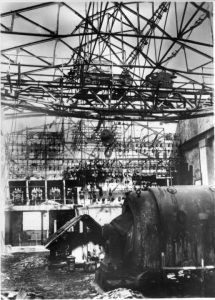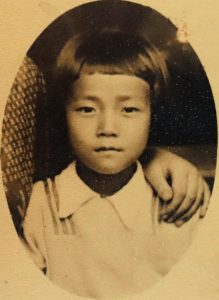Documenting Hiroshima of 1945: October–November, survey of damages to Chugoku Haiden power company
Nov. 1, 2024
Between October and November 1945, Yoshita Kishimoto, who died in 1989 at the age of 87, started to take photographs in the ruins of Hiroshima’s central area, based on a request from the power company Chugoku Haiden (present-day Chugoku Electric Power Co.) to survey damages to its power-distribution facilities.
Mr. Kishimoto’s photos include those of an iron column that had collapsed due to the blast from the atomic bombing, a wooden pole charred by radiant heat on the side of the hypocenter, and the Senda-machi power station, which had been incinerated in the bombing. There are also photos he took of all directions from the rooftop of the company’s head office, located 680 meters from the hypocenter. Thirty of his photos were carried in a report titled “Survey of damages to electrical equipment caused by the atomic bomb,” which the Hiroshima branch of the company had put together in 1946.
From before the war, Mr. Kishimoto managed a photo studio in the area of Tanaka-machi (in Hiroshima’s present-day Naka Ward). He and his wife experienced the atomic bombing in the Ushita-cho area (in the city’s present-day Higashi Ward), a location to which they had been evacuated. His oldest daughter, Sumie, eight at the time, was going to Seibi National School, affiliated with an association known as the Hiroshima Army Kaikosha, located around 700 meters from the hypocenter. Sumie had chosen to attend the school because it served “school lunches with kabocha.” After the bombing, her mother was able to locate their daughter near Kanda Bridge, which connects Ushita with the Hakushima area (in Hiroshima’s present-day Naka Ward). “Mother, you were late to get here,” said Sumie, who died while being transported to a relief station.
Mr. Kishimoto was devastated by their daughter’s death. According to an interview with him carried in the Chugoku Shimbun’s evening edition on October 14, 1978, he said, “With the loss of my daughter, I didn’t feel like picking up my camera.” However, with the opportunity presented by Chugoku Haiden’s request, he decided to take photos as a way to record the disaster, based on his idea that to do so was his “responsibility as a surviving citizen,” as written in the 1971 Record of the Hiroshima A-bomb War Disaster. He continued to operate his photo studio after the war ended. Until 1953, he kept on taking photos from the rooftop of the Chugoku Electric Power Company’s head office, capturing images of the city as it recovered from the bombing.
Mizuyo Kishimoto, 86, a resident of Hiroshima’s Naka Ward and the wife of Mr. Kishimoto’s oldest son, Hiroshi, who died in 2020 at the age of 85, has held on to Sumie’s belongings cherished by Mr. Kishimoto. The belongings include a letter from her addressed to Hiroshi, who had left home after being evacuated away from the city with groups of other school students, in which Sumie wrote, among other sentiments, “Aren’t you lonely there?” Mizuyo said, “After I gave birth to my daughter, my father-in-law adored her to such an extent that he would sleep alongside her until she was in elementary school. I guess she reminded him of Sumie.”
(Originally published on November 1, 2024)
Mr. Kishimoto’s photos include those of an iron column that had collapsed due to the blast from the atomic bombing, a wooden pole charred by radiant heat on the side of the hypocenter, and the Senda-machi power station, which had been incinerated in the bombing. There are also photos he took of all directions from the rooftop of the company’s head office, located 680 meters from the hypocenter. Thirty of his photos were carried in a report titled “Survey of damages to electrical equipment caused by the atomic bomb,” which the Hiroshima branch of the company had put together in 1946.
From before the war, Mr. Kishimoto managed a photo studio in the area of Tanaka-machi (in Hiroshima’s present-day Naka Ward). He and his wife experienced the atomic bombing in the Ushita-cho area (in the city’s present-day Higashi Ward), a location to which they had been evacuated. His oldest daughter, Sumie, eight at the time, was going to Seibi National School, affiliated with an association known as the Hiroshima Army Kaikosha, located around 700 meters from the hypocenter. Sumie had chosen to attend the school because it served “school lunches with kabocha.” After the bombing, her mother was able to locate their daughter near Kanda Bridge, which connects Ushita with the Hakushima area (in Hiroshima’s present-day Naka Ward). “Mother, you were late to get here,” said Sumie, who died while being transported to a relief station.
Mr. Kishimoto was devastated by their daughter’s death. According to an interview with him carried in the Chugoku Shimbun’s evening edition on October 14, 1978, he said, “With the loss of my daughter, I didn’t feel like picking up my camera.” However, with the opportunity presented by Chugoku Haiden’s request, he decided to take photos as a way to record the disaster, based on his idea that to do so was his “responsibility as a surviving citizen,” as written in the 1971 Record of the Hiroshima A-bomb War Disaster. He continued to operate his photo studio after the war ended. Until 1953, he kept on taking photos from the rooftop of the Chugoku Electric Power Company’s head office, capturing images of the city as it recovered from the bombing.
Mizuyo Kishimoto, 86, a resident of Hiroshima’s Naka Ward and the wife of Mr. Kishimoto’s oldest son, Hiroshi, who died in 2020 at the age of 85, has held on to Sumie’s belongings cherished by Mr. Kishimoto. The belongings include a letter from her addressed to Hiroshi, who had left home after being evacuated away from the city with groups of other school students, in which Sumie wrote, among other sentiments, “Aren’t you lonely there?” Mizuyo said, “After I gave birth to my daughter, my father-in-law adored her to such an extent that he would sleep alongside her until she was in elementary school. I guess she reminded him of Sumie.”
(Originally published on November 1, 2024)









